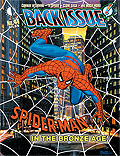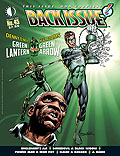
Time for another TV party, friends. Only tonight, we won't be having popcorn and soda. No, we're going to brew up some green tea and contemplate the deep meaning behind Kung Fu.
Kung Fu was eagerly watched in my household. When the show premiered in 1972, the martial arts craze was in full swing. Both my father and brother were studying kenpo karate (and I was lucky enough to be taught some moves by them - the teacher didn't take girls!) and more shows and movies were appearing featuring some form of martial arts. Bruce Lee hadn't quite hit it big in the states yet - Enter the Dragon, the film that would make him a household name, didn't come out til 1973. He was mostly known here for his role as Kato on The Green Hornet TV show. But make no mistake, the martial arts and the esoteric philosophies that accompanied them were gaining ground on U.S. soil.
Television usually takes these trends and cranks out a lot of junk. But with Kung Fu, they had managed to create a show that was capable of balancing action and thoughtfulness - much like the main character, wandering Shao Lin monk Kwai Chang Caine.
Caine w
 as a Shao Lin priest, taught to be peaceful, but also taught the fierce skills of kung fu. Born of an American father and Chinese mother, he was always a man apart, whether it was in China or the American West. After angrily killing the Emperor's nephew because his men had slain Caine's beloved teacher, Master Po, Caine fled to the U.S. to seek out his half-brother. Set in the Old West, Kung Fu was an odd mix of conventional Western and martial arts genres. Caine wanted nothing but peace and solitude, and yet, every week, he became involved in some affair that required the use of his deadly talents.
as a Shao Lin priest, taught to be peaceful, but also taught the fierce skills of kung fu. Born of an American father and Chinese mother, he was always a man apart, whether it was in China or the American West. After angrily killing the Emperor's nephew because his men had slain Caine's beloved teacher, Master Po, Caine fled to the U.S. to seek out his half-brother. Set in the Old West, Kung Fu was an odd mix of conventional Western and martial arts genres. Caine wanted nothing but peace and solitude, and yet, every week, he became involved in some affair that required the use of his deadly talents.The late David Carradine seemed to be the perfect actor for the role. His Caine was possessed of a calm stillness that contrasted nicely with the violent men he encountered. There has been much speculation that the whole idea for the show was stolen from Bruce Lee, and there does seem to be plenty of evidence to support that assertion. But it's hard for me to imagine anyone but Carradine in that role. In many ways, his 'half-breed' (the unenlightened term used in those days) Caine reminded me a great deal of Star Trek's Mr. Spock, who was also a man apart, not able to find a place in either of the worlds he straddled. I think both of these characters had a strong appeal to teenagers and young adults for these very reasons.
Of course, the late 60s and early 70s was also a time in which many people were explo
 ring eastern religions and culture, and so this also made Kung Fu attractive to viewers. Many of my favorite sequences in the show were the flashbacks which took place during Caine's youth in the temple. Usually these involved his teacher, the blind Master Po, played charmingly by Keye Luke. Master Po would give the young Caine, or Grasshopper as he affectionately called him, some lesson in life. These lessons always informed Caine's decisions in the course of an episode. This was back in the day when some shows were not afraid to moralize.
ring eastern religions and culture, and so this also made Kung Fu attractive to viewers. Many of my favorite sequences in the show were the flashbacks which took place during Caine's youth in the temple. Usually these involved his teacher, the blind Master Po, played charmingly by Keye Luke. Master Po would give the young Caine, or Grasshopper as he affectionately called him, some lesson in life. These lessons always informed Caine's decisions in the course of an episode. This was back in the day when some shows were not afraid to moralize.For comics f
 ans, it's worth noting that writer Steve Englehart has stated that Kung Fu was the major influence on the creation of Marvel's Shang-Chi, Master of Kung Fu. He and co-creator Jim Starlin were fans of the show.
ans, it's worth noting that writer Steve Englehart has stated that Kung Fu was the major influence on the creation of Marvel's Shang-Chi, Master of Kung Fu. He and co-creator Jim Starlin were fans of the show.Like most shows that are now decades old, Kung Fu can seem a bit hokey. But I can honestly say, I have seasons 1 and 2 on DVD, and they are packed full of great story-telling, wonderful old character actors, and some pretty cool action sequences (slow-mo, anyone?). It's been a lot of fun to revisit them.
Of course, anyone who watched the show regularly will recall the excellent title sequence, which includes the famous scene with Master Kan intoning, "As quickly as you can, snatch the pebble from my hand." Take a look below.

















































2 comments:
Caine did have some similarity to Spock. In fact, William Shatner was a guest star in a Kung Fu episode ("A Small Beheading") and he and Carradine played well off of each other, just as Shatner and Leonard Nimoy had.
As I understand it, it was Bruce Lee's idea to set the show in the Old West. The reasoning was that the violence would be more plausible-and easier to justify-in a frontier setting.
Post a Comment